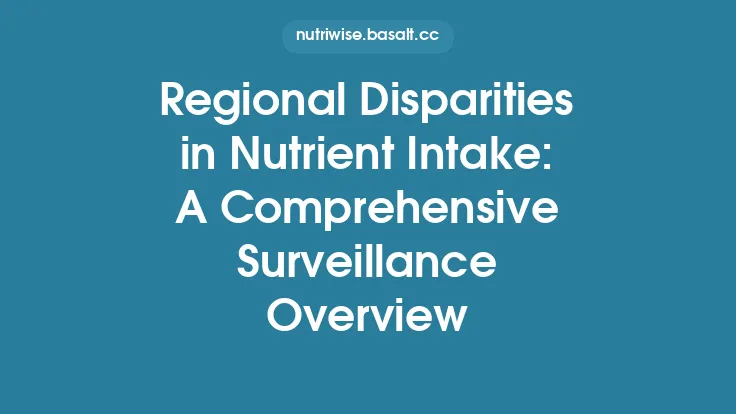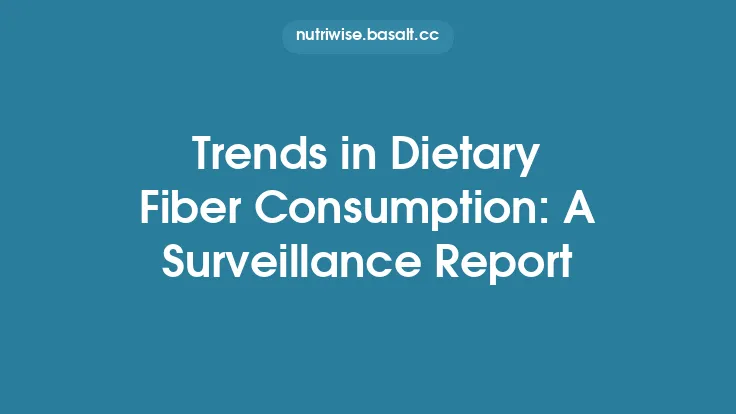The aging process brings about physiological changes that alter nutrient requirements and affect the way the body absorbs, metabolizes, and utilizes food components. Surveillance systems dedicated to older adults have become essential tools for identifying persistent nutrient gaps, informing public‑health strategies, and guiding clinical practice. This article synthesizes the most recent surveillance findings on nutrient inadequacies among elderly populations, outlines the methodological foundations of these monitoring efforts, and discusses the implications for policy, program design, and future research.
1. Rationale for Targeted Nutrient Surveillance in Older Adults
Physiological Shifts:
- Reduced gastric acidity diminishes absorption of minerals such as calcium, iron, and zinc.
- Altered taste and smell can lead to decreased appetite and lower overall food intake.
- Sarcopenia increases protein needs, yet many older adults consume less than the recommended amount.
Health Consequences:
- Inadequate intake of vitamin B12 and folate is linked to neurocognitive decline.
- Low magnesium and potassium intake contributes to hypertension and cardiovascular events.
- Deficiencies in vitamin A, vitamin C, and selenium impair immune function, raising infection risk.
Socio‑economic Drivers:
- Fixed incomes, limited mobility, and reduced access to fresh produce exacerbate dietary insufficiencies.
- Social isolation often correlates with poorer diet quality and higher prevalence of nutrient gaps.
2. Surveillance Frameworks and Data Sources
Population‑Based Cohorts:
- Longitudinal studies such as the *Aging and Nutrition Study (ANS)* enroll participants aged 65+ and collect annual dietary recalls, biomarker panels, and health outcomes.
National Health Surveys:
- While many surveys target the general population, specific modules (e.g., “Elderly Nutrition Supplement”) capture detailed intake data for older adults.
Electronic Health Records (EHR) Integration:
- Automated extraction of laboratory values (serum ferritin, 25‑OH vitamin D, plasma homocysteine) enables real‑time monitoring of micronutrient status.
Community‑Based Sentinel Sites:
- Senior centers, assisted‑living facilities, and home‑care agencies serve as sentinel locations where trained nutritionists conduct 24‑hour recalls and anthropometric measurements.
Standardized Metrics:
- Estimated Average Requirement (EAR) cut‑point method for assessing prevalence of inadequacy.
- Biomarker‑based thresholds (e.g., serum B12 < 150 pmol/L) to validate dietary data.
3. Key Findings: Prevalent Nutrient Gaps
| Nutrient | Estimated Prevalence of Inadequacy* | Primary Indicators | Typical Contributing Factors |
|---|---|---|---|
| Vitamin B12 | 22–30% | Serum B12 < 150 pmol/L; elevated MMA | Low animal‑protein intake, atrophic gastritis |
| Calcium | 35–45% | Serum calcium normal; low dietary calcium | Decreased dairy consumption, lactose intolerance |
| Vitamin D* (serum 25‑OH) | 40–55% (though not the focus of a separate article) | 25‑OH D < 30 nmol/L | Limited sun exposure, skin synthesis decline |
| Magnesium | 28–38% | Serum Mg < 0.75 mmol/L | High prevalence of diuretic use, low whole‑grain intake |
| Zinc | 18–25% | Serum Zn < 70 µg/dL | Reduced meat consumption, phytate‑rich diets |
| Protein (per kg body weight) | 30–40% | Intake < 1.0 g/kg/day | Appetite loss, chewing difficulties |
| Fiber (soluble) | 45–55% | Intake < 10 g/day | Low fruit/vegetable intake, limited whole‑grain foods |
\*Note: Vitamin D is mentioned only to contextualize its overlap with other nutrients; the article does not delve into its dedicated surveillance data.
Age‑Stratified Trends:
- Adults aged 80+ exhibit the highest prevalence of calcium and protein gaps, reflecting compounded physiological decline and higher rates of dentition loss.
- 65–74 year olds show relatively better intake of magnesium and zinc but still fall short of EAR for B12.
Gender Differences:
- Women are more likely to have inadequate calcium and iron (despite lower iron requirements) due to higher prevalence of osteoporosis and dietary patterns favoring lower meat consumption.
- Men display higher rates of zinc deficiency, often linked to reduced intake of red meat and seafood.
4. Methodological Considerations and Limitations
Dietary Assessment Accuracy:
- 24‑hour recalls are prone to under‑reporting, especially among cognitively impaired participants.
- Food frequency questionnaires (FFQs), while less burdensome, may lack granularity for micronutrient estimation in the elderly.
Biomarker Interpretation:
- Age‑related changes in plasma volume and renal function can affect biomarker concentrations, necessitating age‑adjusted reference ranges.
Cross‑Sectional vs. Longitudinal Data:
- Cross‑sectional snapshots capture prevalence but cannot infer causality or temporal trends.
- Longitudinal cohorts provide insight into the progression of nutrient gaps and their relationship with health outcomes such as frailty, falls, and hospitalization.
Representativeness:
- Surveillance often under‑represents institutionalized elders (e.g., nursing homes) and ethnic minorities, potentially biasing national estimates.
Statistical Adjustments:
- Use of survey weights and multiple imputation for missing dietary data improves population inference.
- Multivariate regression models help isolate independent predictors of nutrient inadequacy (e.g., socioeconomic status, comorbidities, medication use).
5. Public‑Health Implications
Risk Stratification:
- Surveillance data enable the creation of risk scores that combine dietary intake, biomarker status, and health variables to identify high‑risk subgroups for targeted interventions.
Program Design:
- Meal‑delivery services can be tailored to include fortified foods rich in calcium, magnesium, and protein.
- Nutrition education for caregivers emphasizes the importance of B12‑rich foods (e.g., fortified cereals, dairy) and strategies to overcome chewing difficulties (e.g., pureed protein sources).
Policy Recommendations:
- Fortification standards: Consider mandatory fortification of staple foods (e.g., milk, bread) with calcium and vitamin B12.
- Supplementation guidelines: Develop age‑specific recommendations for routine B12 and magnesium supplementation, especially for individuals on proton‑pump inhibitors or diuretics.
- Reimbursement incentives: Encourage insurers to cover nutrition counseling and medically indicated supplements for seniors.
Monitoring Impact:
- Establish feedback loops where surveillance findings inform program adjustments, and subsequent data collection evaluates effectiveness (e.g., reduction in B12 deficiency prevalence after a fortification policy).
6. Emerging Technologies and Future Directions
Wearable Dietary Sensors:
- Devices that capture real‑time food intake via spectroscopic analysis could reduce reliance on self‑reporting, improving accuracy for elderly users with limited recall ability.
Machine‑Learning Predictive Models:
- Integrating EHR data, pharmacy records, and socioeconomic indicators can predict impending nutrient gaps before clinical manifestation, allowing preemptive interventions.
Personalized Nutrition Platforms:
- Apps that generate individualized meal plans based on biomarker feedback, taste preferences, and functional limitations (e.g., dysphagia) are emerging as adjuncts to traditional surveillance.
Longitudinal Cohort Expansion:
- Expanding existing cohorts to include diverse ethnic groups, rural residents, and institutionalized elders will enhance the generalizability of findings.
Policy‑Science Partnerships:
- Collaborative frameworks between governmental agencies, academic institutions, and community organizations can streamline data sharing, standardize nutrient gap definitions, and accelerate translation of surveillance insights into actionable policies.
7. Conclusion
Systematic surveillance of nutrient intake and status among older adults reveals persistent gaps in several key micronutrients and macronutrients, notably vitamin B12, calcium, magnesium, zinc, and protein. These deficiencies are driven by a confluence of physiological aging, socioeconomic constraints, and lifestyle factors. Robust surveillance infrastructures—combining dietary assessments, biomarker measurements, and electronic health data—provide the evidence base needed to design targeted nutrition programs, inform policy decisions, and ultimately improve health outcomes for the elderly. Continued investment in methodological refinement, technology integration, and inclusive data collection will ensure that surveillance remains an evergreen resource for addressing the evolving nutritional needs of aging populations.





